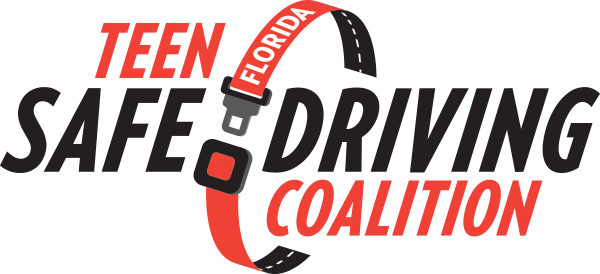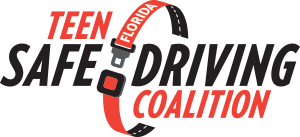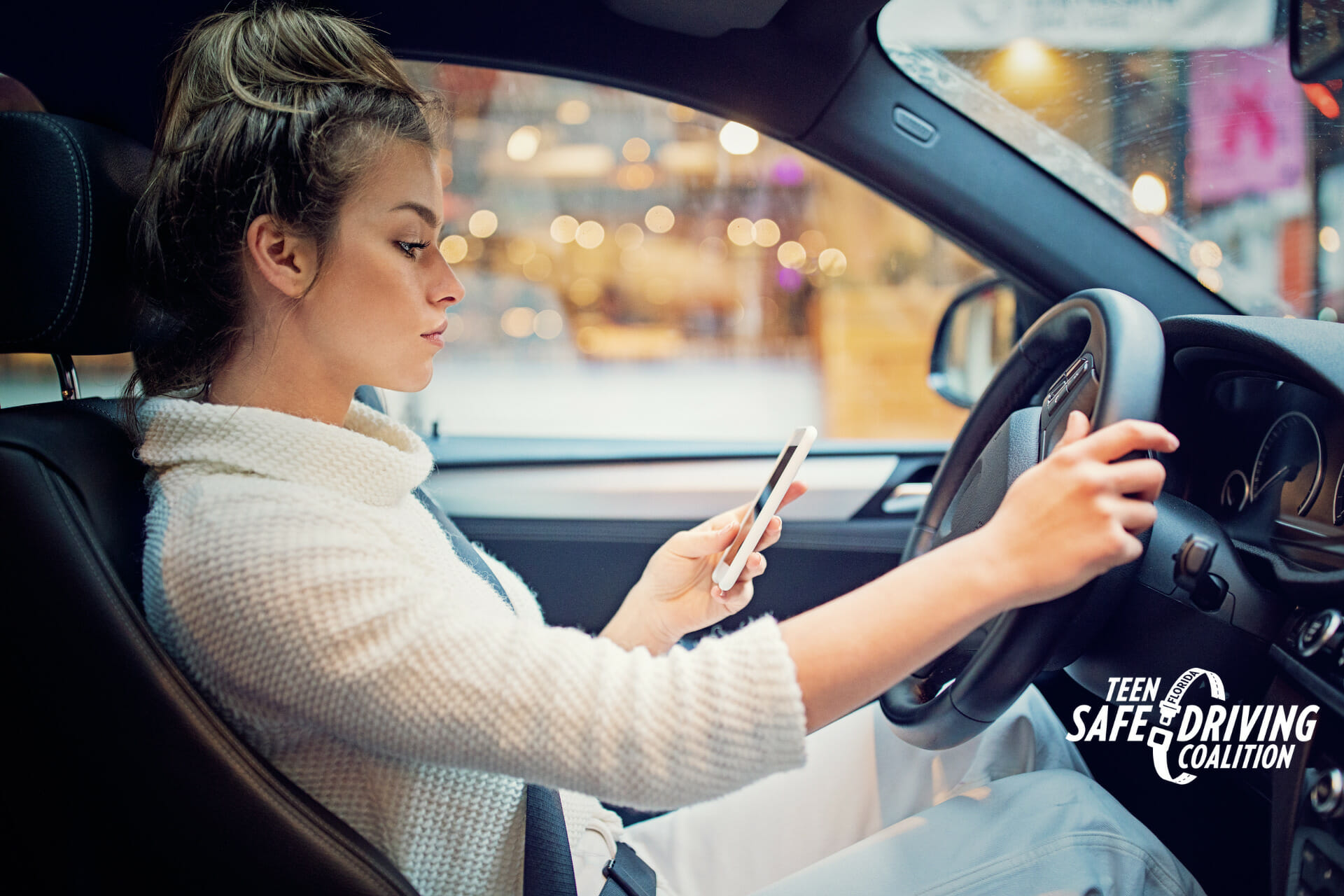
Texting & Driving – A Serious Problem
We All Make Mistakes, But You Can Avoid Making This One… Texting and driving is a serious problem and can lead to some serious repercussions.
TEXTING AND DRIVING STATS
In a study conducted in February 2019, 69% of drivers from the United States between the ages of 18 and 64 expressed that they use their cell phone whilst driving. Texting and driving is a well-known and deeply researched issue, yet individuals around the world continue to text and drive, resulting in many accidents, injuries, and deaths. Therefore, there is great weight in continuously educating ourselves and the public of the dangers of texting and driving because education on this matter can result in ability to save lives.
The cost of texting and driving is often both personal and political. The costs include accident repair costs, emotional damage as a result of an accident, and can even cost one’s life or the life of others.
- In 2018, ~4,637 people died in car crashes as a result of cell phone use.
- 40% of teens express how they’ve experienced being in a car with a driver using a cell phone which put them in a dangerous situation
- Each day, 11 teens die in crashes caused by texting and driving
- Accidents involving cell phone use cost $129 billion in 2018
- Texting while driving causes accidents six times more than drunk driving.
SellMax has conducted our very own national survey of 10,000 drivers between the ages of 18-60 across the U.S to determine their views on texting and driving. Exploring individuals views on texting and driving can lend to a safer society as this information allows us to understand where the desire/societal pressure to text and drive comes from. This information can, therefore, lend to implementing resources to reduce the temptation and pressure to text and drive.
- 87% of drivers surveyed expressed that they text and/or talk on their phone whilst driving
- 15% of those drivers who admitted to texting and/or talking on their phone whilst driving have been involved in some sort of texting and driving accident. Therefore, from our statistics, 1,305 people admitted to being involved in an accident as a result of phone use whilst driving.
- Over 50% of the drivers who admit to using their phone whilst driving express they did so because they believe they are able to multitask and felt as if they were safe
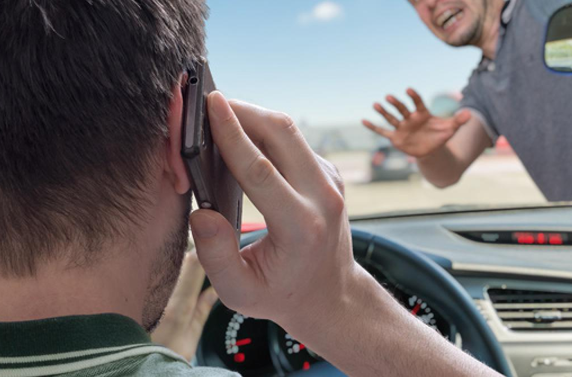
This information makes is clear that there is a need to educate individuals further on the dangers of multitasking whilst driving. Although driving is a daily task for many individuals, it is also a task which requires deep responsibility and awareness of our environment and of those around us. Research shows that it takes just three seconds for a crash to occur once a driver becomes distracted whilst driving and that brake reaction speed can be 18% slower whilst texting and driving. As cell phones are a major point of distraction, whether driving or not, it’s essential to have a deeper understanding of the role of cell phones as a major cause of car accidents, injuries, and death.
WE’RE TALKING ABOUT THIS AGAIN?
Yep. Again. And you’ll probably hear about the dangers of texting and driving many more times. Again and again and again.
Why? Well, you can probably guess the answer: because it’s that important to know just how dangerous texting and driving is, and if sharing this information can help keep someone safe, then all the more reason to drill it in to everyone.
So let’s talk about it.
THE DANGEROUS ALLURE OF CELL PHONES
Considering it’s something small enough to hold in one hand, cell phones hold a powerful position in our daily lives.
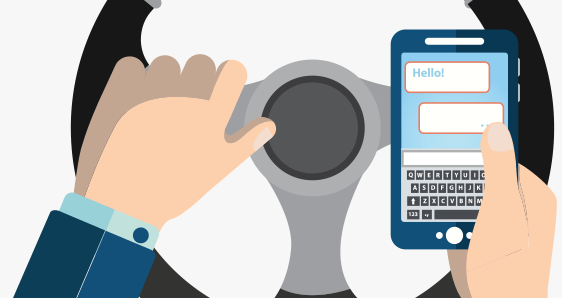
I <3 TECHNOLOGY
Cell phones, and technology in general, can be so convenient. Phones nowadays might as well be called mini computers. Not only do we call and text on them, but we also have access to the Internet as well as so many apps that we can do anything from playing games to working on our phones.
Smart phones are a great invention, and they have definitely impacted our culture and how we go about our daily lives. So, don’t get me wrong, this article isn’t about cell phone bashing. It’s about making sure we’re the ones in control, that we’re using our phones and our phones aren’t using us.
ITCH/SCRATCH RESPONSE
Bzzz! Your phone vibrates, and your eyes automatically dart toward it. Is it an app notification? Did someone text you? What’s waiting for you when you unlock the screen? More likely than not, you want to drop whatever you’re doing and check your phone.
I think of this as the Itch/Scratch Response because just like an itch that we automatically try to scratch when we first feel it, we’ve grown accustomed to automatically responding when our phone goes off. And if we don’t scratch that itch or check our phones right away, it’s a constant pinging in our head that we should.
It might not be fun to admit, but our phones have us pretty well trained.

BUT I’M GOOD AT IT
Let’s tie this back into texting and driving. You’re in the car, your phone goes off, and you take one hand off the steering wheel to reach for it….
Wait. Stop! Did you really do that?
But your eyes and hand were only focused on your phone for a few seconds right? Besides you’re so fast at using your phone that you’re, dare I say it?, good at using your phone while driving. And if you’re good at it, then you must not be a hazard, right?
Hmmm…let’s see about that.
DISTRACTED MUCH?
It’s hard to be 100% distraction proof. For survival purposes, our bodies are wired to react when there is a change in our environment, but that response is supposed to keep us safe. Distracted driving, on the other hand, makes our environment more dangerous.
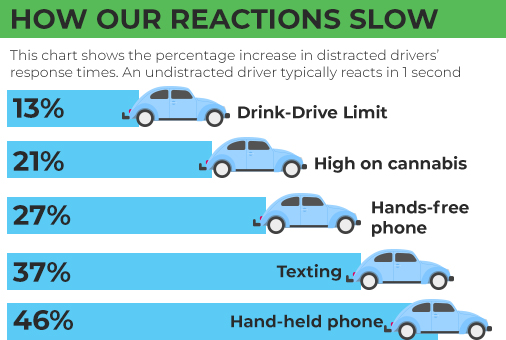
DISTRACTED DRIVING
The Center for Disease Control (CDC) points out that there are three types of distraction we are susceptible to while driving. They are visual, manual, and cognitive.
Visual distractions consist of anything that pulls your eyes away from focusing on the road. Manual distractions happen when you remove a hand or both hands from the steering wheel. Cognitive distractions involve things that draw your mind away from the task of driving.
When you text and drive you are engaging in all three distraction types to some extent, and while it may not seem like your distracted long enough to for it to be anything to worry about, those few seconds that you’re glancing at your screen can mean hundreds of yards going by without you watching the road. And that’s a long time to be driving blind.
NO SUCH THING AS MULTITASKING
“Multitasking” is a word we hear a lot. We like to think we are capable of doing many things at once, and that it is more efficient. However, studies have found that there is no such thing as true multitasking. Turns out your brain can’t process two separate things simultaneously. Instead, your brain flips back and forth between each task you are trying to do.
In other words, it is impossible to truly handle using your phone and being cognitively aware of what’s going on around you at the same time.
STILL DOUBTING HOW SERIOUS THIS IS? HERE ARE SOME STATS AND DATA ABOUT TEXTING AND DRIVING
Sometimes there’s nothing like some cold, hard facts to help people grasp a situation. In that case, here are some data gathered from 2012-2018 about texting and driving for your brain to munch over.
CRASH STATS
- •A reported 1.5 million crashes were shown to be the result of using a cell phone while driving.
- •9% of all nation-wide fatalities from car crashes were caused by texting and driving.
- •In 2018, 4,637 lives were lost due to texting and driving.
- •You’re 6 times as likely to get in a wreck because of texting and driving when compared to drinking and driving.
So just how many people are texting and driving? And which age groups do it the most? The biggest chunk of people documented as using their cell phones while driving is those in their 20s, followed by those in their 30s, and then those in their late teens.

These are the age groups whose decision to not use their phones to text and drive can have the largest impact on texting and driving statistics overall. Everyone should put down their phone while driving, but if you’re in this age range, your even more of a key player in keeping roads safe in regard to this issue.
LIVING FOR LOGAN: A REAL LIFE STORY
On September 15, 2016, the Scherer’s and their two children, Logan (9) and Mallory (5), were driving down Interstate 75. They slowed the car to a stop when they came upon traffic.
Unfortunately, another driver did not stop in time and rammed into the back of their car. It turned out this driver had been texting and surfing the Internet while driving.
Both injured parents survived. Sadly 9 year-old Logan died, and little Mallory had serious injuries, including a broken femur.
It’s a sad story that could have easily been avoided, and that’s what the Scherer’s are stressing with their nonprofit Living for Logan. They advocate against using phones while driving and are pushing for stricter laws and punishments in regard to driving and handling a phone. The Scherer’s can’t get their son back, but they want to stop the same tragedy from happening to other families.
PHYSICAL HARM ISN’T THE ONLY HARM TEXTING AND DRIVING CAN DO
We’ve heard a lot about texting and driving leading to wrecks. These incidents might cause serious injury or death. We might even know someone that experienced this, but have you ever stopped to think what other consequences can come when you let your phone barge in on your driving time?
INSURANCE RECORDS
As with other tickets, a ticket for texting and driving will show up in your insurance records, and that most likely means an increase in your car insurance rates. Insurers in all states have penalties for distracted driving as of 2017. In fact, your rate could go up as much as 16%. And that’s not a pretty sight.
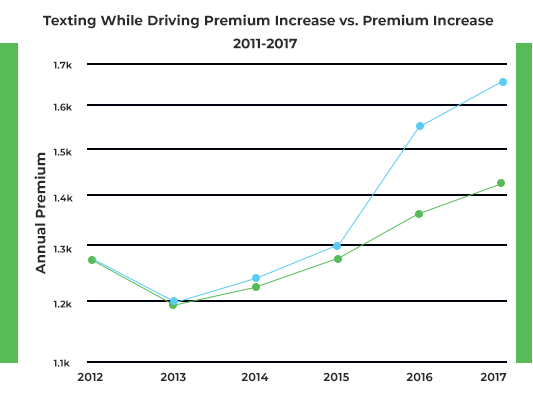
LAWS
Aside from Montana, Arizona, and Missouri, all other states have a texting ban. So, chances are high that wherever you’re driving and texting, you are doing something illegal on top of it being something dangerous.
Breaking this law could result in a misdemeanor, and if someone is hurt as a result of you texting and driving you could end up spending time in jail or prison.

FINES
With getting caught breaking the law by texting and driving comes a ticket and a fine. How much the fine costs varies by state. For some, a first time offense will cost you as little as $20 (California) while for others it could reach as high a price as $200 (Nebraska). If you want to know what a texting and driving ticket could cost you in the state you live in you can check out this site.
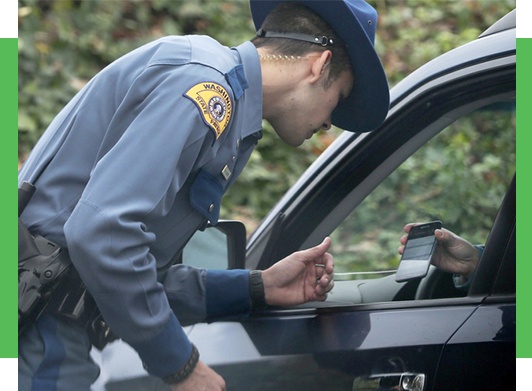
CAREERS
Having a record for texting and driving won’t always affect your chances of getting a job, but according to backgound checking websites, offenses involving reckless driving (which texting and driving would fall under) can appear on a criminal record.
Employers will most likely be influenced by your driving record if you are applying for a job that requires you to drive. Some of these include working for a trucking or taxi business. However, it doesn’t look good on your record either, especially if someone was hurt because of texting and driving.
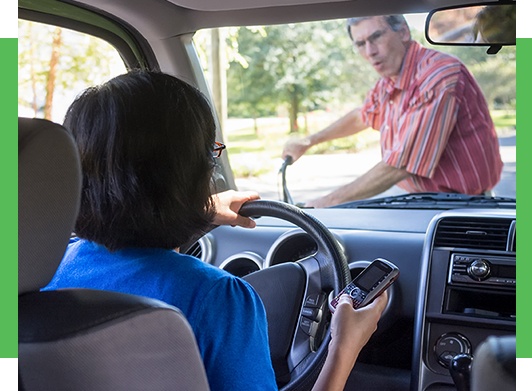
WHAT CAN YOU DO ABOUT IT?
With the proportion of texting and driving going on in the world, it might feel like what you choose to do won’t change anything, but there are ways you can make a difference. And they are so easy to implement.
PLAY HIDE AND SEEK WITH YOUR PHONE
Sometimes the old saying “out of sight, out of mind” really rings true. The simplest way to ensure that you don’t use your cell phone while driving is to put it somewhere you can’t see it and can’t reach it. There are a number of places to hide your phone before you start driving. You can put it in the glove compartment or even in the backseat. Placing it inside a zipped up purse or bag can muffle any notification sounds that can be distracting If you’re really worried about hearing your phone going off and being tempted to get it, you can set your phone to silent while you’re in the car.
BE AN EXAMPLE
You might be surprised at how many people you know look to you as an example. It could be a younger sibling, a niece, a nephew, or even a friend. Take steps to prevent yourself from texting and driving and let others see it. Our actions tend to impact others more than our words. If those around you see you care about driving safely, they might start to care more too.
EDUCATE YOURSELF
You are already on your way with this one. You’ve taken the time to read this article, and some of the information has already seeped into your brain. Now you know more about why texting and driving is bad, and gaining knowledge about a subject helps you make better decisions.
RAISE AWARENESS
Another thing you can do is follow the example of Logan’s parents from the story earlier. You can set out to raise awareness about the dangers of distracted driving and let people in government know this is a topic that deserves discussion and action in order to help keep people safe.
SO, IT’S KINDA A BIG DEAL AFTER ALL
When it comes to driving, just seconds of distraction can have a huge impact on our lives. Not only that, but it can cost us our lives or the lives of others around us. Each one of us behind the wheel has a responsibility to drive safely. You’re not just driving for you when you’re out there on the road. You’re also driving for everyone around you.
So, go ahead. Put the phone down.
SOURCES
https://www.cdc.gov/motorvehiclesafety/distracted_driving/index.html
https://www.nsc.org/driveithome/resources/teen-safe-driving-coalitions
www.drivinglaws.org/indexhf.php
https://www.legalmatch.com/law-library/article/texting-while-driving-laws.html
https://www.hg.org/legal-articles/can-traffic-tickets-affect-my-employment-48050
Original Post Source: https://sellmax.com/texting-and-driving/
